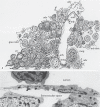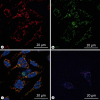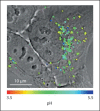Particulate systems for targeting of macrophages: basic and therapeutic concepts
- PMID: 22722900
- PMCID: PMC6741456
- DOI: 10.1159/000339153
Particulate systems for targeting of macrophages: basic and therapeutic concepts
Abstract
Particulate systems in the form of liposomes, polymeric micelles, polymeric nano- and microparticles, and many others offer a rational approach for selective delivery of therapeutic agents to the macrophage from different physiological portals of entry. Particulate targeting of macrophages and intracellular drug release processes can be optimized through modifications of the drug carrier physicochemical properties, which include hydrodynamic size, shape, composition and surface characteristics. Through such modifications together with understanding of macrophage cell biology, targeting may be aimed at a particular subset of macrophages. Advances in basic and therapeutic concepts of particulate targeting of macrophages and related nanotechnology approaches for immune cell modifications are discussed.
Copyright © 2012 S. Karger AG, Basel.
Figures











Similar articles
-
Targeting to macrophages: role of physicochemical properties of particulate carriers--liposomes and microspheres--on the phagocytosis by macrophages.J Control Release. 2002 Feb 19;79(1-3):29-40. doi: 10.1016/s0168-3659(01)00549-1. J Control Release. 2002. PMID: 11853916 Review.
-
Particle engineering to enhance or lessen particle uptake by alveolar macrophages and to influence the therapeutic outcome.Eur J Pharm Biopharm. 2015 Jan;89:163-74. doi: 10.1016/j.ejpb.2014.12.001. Epub 2014 Dec 10. Eur J Pharm Biopharm. 2015. PMID: 25497488 Review.
-
In vitro evaluation of hexagonal polymeric micelles in macrophage phagocytosis.Macromol Rapid Commun. 2011 Sep 15;32(18):1442-6. doi: 10.1002/marc.201100157. Epub 2011 Jul 5. Macromol Rapid Commun. 2011. PMID: 21732463
-
Polymeric particulate technologies for oral drug delivery and targeting: a pathophysiological perspective.Nanomedicine. 2012 Sep;8 Suppl 1:S5-20. doi: 10.1016/j.nano.2012.07.005. Epub 2012 Jul 27. Nanomedicine. 2012. PMID: 22846372 Review.
-
Pharmaceutical aspects of intranasal delivery of vaccines using particulate systems.J Pharm Sci. 2009 Mar;98(3):812-43. doi: 10.1002/jps.21493. J Pharm Sci. 2009. PMID: 18661544 Review.
Cited by
-
Heavy Chain Only Antibodies: A New Paradigm in Personalized HER2+ Breast Cancer Therapy.Bioimpacts. 2013;3(1):1-4. doi: 10.5681/bi.2013.009. Epub 2013 Jan 27. Bioimpacts. 2013. PMID: 23678463 Free PMC article.
-
Macrophages: past, present and future.J Innate Immun. 2013;5(6):657-8. doi: 10.1159/000356293. Epub 2013 Oct 26. J Innate Immun. 2013. PMID: 24192658 Free PMC article. No abstract available.
-
Unexpected and novel functions of complement proteins.J Innate Immun. 2014;6(4):405-6. doi: 10.1159/000363198. Epub 2014 May 20. J Innate Immun. 2014. PMID: 24853386 Free PMC article. No abstract available.
-
Sinusoidal immunity: macrophages at the lymphohematopoietic interface.Cold Spring Harb Perspect Biol. 2014 Dec 11;7(4):a016378. doi: 10.1101/cshperspect.a016378. Cold Spring Harb Perspect Biol. 2014. PMID: 25502514 Free PMC article. Review.
-
Summary report of PQRI Workshop on Nanomaterial in Drug Products: current experience and management of potential risks.AAPS J. 2015 Jan;17(1):44-64. doi: 10.1208/s12248-014-9701-9. Epub 2014 Nov 25. AAPS J. 2015. PMID: 25421459 Free PMC article.
References
-
- Gordon S. Vol. 158. Berlin: Springer; 2003. The Macrophage as Therapeutic Target.
-
- Moghimi SM, Hunter AC, Murray JC. Long-circulating and target-specific nanoparticles: theory to practice. Pharmacol Rev. 2001;53:283–318. - PubMed
-
- Moghimi SM, Hunter AC, Murray JC. Nanomedicine: current progress and future prospects. FASEB J. 2005;19:311–330. - PubMed
-
- Taylor PR, Martinez-Pomarez L, Stacey M. Macrophage receptors and immune recognition. Ann Rev Immunol. 2005;23:901–944. - PubMed
-
- Sleyster EC, Knook DL. Relation between localization and function of rat liver Kupffer cells. Lab Invest. 1982;47:484–490. - PubMed
Publication types
MeSH terms
Substances
LinkOut - more resources
Full Text Sources

